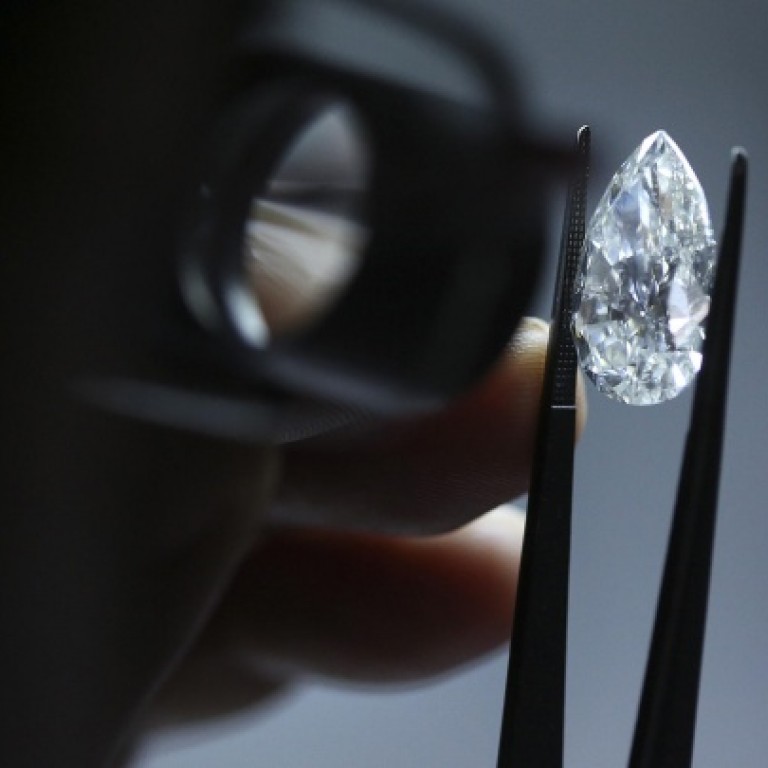
Diamonds are trumps as price of gold wobbles
Some mainland investors are eschewing gold as a long-term store of value and going for something that is more stable - and wearable
Tan Jun has kept a cool head as he watched family and friends rush to buy gold bars and jewellery over the past month in the hope of benefiting from the slump in the price of gold.
In the view of Tan, an e-commerce businessman in Guangzhou, there are better choices than gold when it comes to combating inflation.
"Gold is still too risky for a prudent investor like me. I prefer diamonds, which enjoy a more stable return," Tan said.
Tan, 33, was introduced to the attractions of buying diamonds in a big way last year when he set off to buy an anniversary gift for his wife and ended up making a serious investment by buying a one-carat top-quality diamond for 150,000 yuan (HK$189,000) from an online shop.
"I had bought some diamond necklaces and rings for my wife before, priced at 10,000 to 20,000 yuan," Tan said. "Then I realised diamonds can also be a good option when it comes to trying to preserve value. The better the stone's quality, the higher its future value could be."
I realised diamonds can also be a good option when it comes to trying to preserve value. The better the stone's quality, the higher its future value could be
Over the past nine months, the market price of stones of a similar size and quality has grown around 10 per cent, Tan said. "Now I'm considering making a regular investment and buying one stone every one or two years."
The diamond market in China was mainly fuelled by demand from wealthier consumers who are embracing Western wedding traditions. But it is now attracting more and more local investors who believe diamonds can provide long-term stable value growth compared to stocks, bonds or even gold.
The trend has become even more obvious as the price of gold plummets. He Yu, a spokesman for Davidnile, the largest online diamond and diamond jewellery seller in China, said up to 35 per cent of the company's sales revenue in April came from big stones weighing one carat or more, and the majority of the purchases were for investment.
Before, big stone sales usually accounted for around 20 per cent of total sales.
"Current demand is especially high considering it was a wedding season. The demand for rings and other jewellery also grew fast," He said. The biggest deal during the month came from a male customer who spent more than 600,000 yuan for a three-carat stone.
China overtook Japan in 2011 to become the world's second largest diamond consuming nation, behind the United States. The diamond market in China has seen compound annual growth of 32 per cent since 2005, and annual sales are now approaching US$9 billion, a report this year by the consulting firm Bain & Co found.
"The long-standing preferences for gold and jade, both associated with good fortune, are being supplanted by a fascination with Western culture, with an extra boost from lower taxes and tariffs on diamonds," the report said.
He said most investors shopping on the company's site were males living in first-tier cities such as Beijing, Shanghai, Guangzhou, and Shenzhen. They were aged between 30 and 45 and they usually purchased big stones priced at 30,000 yuan or above.
Davidnile, based in Shenzhen and founded in 2005, expects this year's revenue to grow some 20 per cent from last year's 100 million yuan, with spending on the big stone segment rising by some 30 per cent.
Liu Xiang, an employee of a financial company in Shenzhen, started to pay attention to the diamond investment market two years ago and bought his first stone at Davidnile last January. The one-carat stone cost him more than 700,000 yuan.
Liu, a veteran investor, also put his money in local stock and fund markets. However, diamonds appealed to him more, because he believed their prices were free of "interference".
"The stock and fund markets [on the mainland] are partly controlled by the government; the gold price is hard to predict as gold reserves are a common financial tool used in many countries to manipulate currency exchange rates. But the diamond price is mostly decided by several diamond miners in the world and it's more transparent and predictable," Liu said.
In addition, he said, diamonds were small and lightweight, convenient to carry, and could easily be made into jewellery to wear.
But in spite of these advantages and growing demand, diamonds are unlikely to rival gold's pre-eminent position as an investment in Asian countries in the foreseeable future, not only because of a long tradition of buying gold, but because of the lack of buy-back services for valuable diamonds.
So far very few retailers in the country offer diamond buy-back services for customers, and the process is usually complicated. Pawnshops, when buying diamonds from customers, would usually pay only a fraction of the diamond's retail price and cannot become a mainstream channel for diamond liquidation.
However, this is not a big problem for Tan. He made his diamond into a ring and gave to his wife.
"I don't think I will sell it easily," Tan said. "Now my wife is wearing it. In future, it will be given to our daughter. It carries our love."
